An iconographic and text archive related to communication, technology and art.
☛ LIFE: “Tereska Draws Her Home”, photo by David Seymour, Vol. 25, No. 26, December 27, 1948, p. 16.
The original caption reads as follow:
Children’s wounds are not all outward. Those made in the mind by years of sorrow will take years to heal. In Warsaw, at an institute which cares for some of Europe’s thousands of “disturbed” children, a Polish girl named Tereska was asked to make a picture of her home. These terrible scratches are what she drew. (p. 17)
[UPDATE–April 15, 2017] In April 2017, new information emerged regarding the identity of the young Polish girl depicted in the photography taken by David Seymour. The information is the result of a collaborative effort between the Tereska Foundation, Polish researcher Patryk Grazewicz and humanrights journalist Aneta Wawrzynczak. They were assisted in their research by Magnum Photos and by photography historian Carole Naggar.
- The information was first made public on March 30, 2017 in an article written by Aneta Wawrzynczak for the Polish newspaper Rzeczpospolita: “Tereska. Rozwiązujemy zagadkę słynnego zdjęcia”.
- On April 12, 2017 TIME LightBox published an in-depth piece written by photography historian Carole Naggar explaining the findings and providing more context: “Unraveling a 70-Year-Old Photographic Mystery”.
- The findings were unveiled at the opening gala for a new exhibition about the life and work of the photojournalist who took the picture, David “Chim” Seymour, at The Museum of the Jewish People (Beit Hatfutsot) in Tel Aviv: Capturing History: The Photography of Chim. The exhibition, developped in collaboration with David Seymour’s niece and nephew Helen Sarid and Ben Shneiderman, opened at the end of March 2017 and will run until January 2018.
I thank Patryk Grażewicz for alerting me of those findings, as well as Helen Sarid and Ben Shneiderman for providing complementary information.
• • •
Magnum has two slightly different portraits of Tereska, taken at slightly different moments while she was drawing on the blackboard. On one, her name is still clearly visible on the upper section of the board, while on the other, the name has been covered with her drawings. Notice also how Magnum has turned her name into “Teresa” in the captions. Limited, signed prints of the photo on the right are being sold by Magnum.

When it was reproduced on the cover of the UNESCO Courier of February of 1949, the photo of Tereska was accompanied by the following captions:
Tereska, a small girl at a special school for war-handicapped children recently constructed in Warsaw, Poland, was asked to draw her house and family. She produced this representation of her confused mind ― wavering chicken-track lines crisscrossing each other. What is it that she sees when the teachers say “draw a house”? Is it the memory of terror and the fact or ruins? Are not chicken-track lines of this little child’s drawing but the reflection of an uprooted life, the mirror of disorder and chaos which the war has strewn over Europe? (p. 1; PDF 3.4MB: English, French, Spanish)
In a much more recent essay, photography historian Carole Naggar wrote about the image of Tereska:
Terezka is cared for at a Polish center for disturbed children. She produced these scrawls when asked to draw a picture of her home. Terezka’s portrait, one of Chim’s best-known pictures, has been used as a cover for books on fear, on trauma, and on the Holocaust, and is an eponymous symbol for the German foundation Terezka. (TIME LightBox: “A Second Look: Chim’s Children of War” by Carole Naggar, January16, 2013)
Those two photos can also be found at the Howard Green Gallery (inventory no. PF63424), at the Art Institute of Chicago, at the Museum of Contemporary Photography (also in Chicago) as well as at the International Center of Photography (direct link to image).
According to the video portrait “Chim’s ‘Children of Europe’” narrated by Carole Naggar and uploaded on Vimeo on January of 2013, the photo was included in the legendary photography exhibition curated by Edward Steichen when it opened at the Museum of Modern Art, in 1955 (see @4m55). See the exhibition description and a PDF of the original press release from 1955 at the MoMA archives. There is more information about Steichen’s exhibition at the end of this post.
Chim photographed other kids doing the same exercise: drawing their homes on the blackboard. None seems to be as distressed as Tereska.


• • •
David Seymour (or Chim) was born Dawid Szymin in Warsaw (Poland), in 1911. In 1947, he co-founded the photojournalist cooperative Magnum Photos (along with Robert Capa and Henri Cartier-Bresson, among others). After Capa’s death in 1954, he occupied the function of president until he died in 1956.
In 1948, he accepted a job assignment offered by UNESCO Director of Mass Communications and Public Information John Grierson. Carole Naggar explains:
In the Spring of 1948, Chim was given a mission by the newly founded UNICEF: report on the fate of the 13 million children across Europe who have been left homeless and/or in dire need by the Second World War, and assess their progress through help that the organization provided in the form of shelter, meals, clothes and vaccinations.
His assignment soon became a labor of love: he worked for six months and shot 257 rolls of film with his Rollei and Leica, accepting a token sum of $2,600 instead of his customary $100 a day fee. From the spring to the fall of 1948, he traveled through five European countries: Austria, Greece, Italy, Hungary and his native Poland.
After he completed the assignment, Chim had little time for editing his contact sheets beyond preparing the book, Children of Europe, which was published by UNESCO in 1949 with fifty-two photographs. He also readied several features, including a story for the UNESCO Courier and one for LIFE magazine. (“A Second Look: Chim’s Children of War”; see also UNICEF: “UNICEF’s first international photographer” by Ellen Tolmie, July 10, 2013).
The photos he took for this assignment received a renewed attention recently when the International Center of Photography (New York) held the exhibition We Went Back: Photographs from Europe 1933–1956 by Chim (January 18 to May 5, 2013; catalogue, press release: PDF). The exhibition featured 150 photographs taken by Chim between 1933 and 1956. The photos where also exhibited at the Howard Green Gallery from February 1st to February 23, 2013.
In February of 2013, Umbrage Editions released a 144-page album titled Chim: Children of War (Amazon), which was edited by photography historian and poet Carole Naggar. Naggar narrated another video portrait of David Seymour produced by UNICEF and uploaded online on July of 2013: “Chim: UNICEF’s first international photographer”:
A selection of David Seymour photos from his assignment was previously published as a 57-page book produced by UNESCO and published in various languages: Children of Europe: photos by David Seymour (Unesco publication no. 403, Paris: UNESCO, 1949; PDF 9MB: English, French). The photos are preceded by an essay by Seymour titled “Letter to a grown up”. Here’s an excerpt:
I would like to speak a little about myself, but mainly about the 13,000,000 abandoned children in Europe who had their first experience of life in an atmosphere of death and destruction, and who passed their first years in underground shelters, bombed streets, ghettoes set on fire, refegee trains and concentration camps. The survivors have grown up in a world of fear ―not the healthy fear which a young savage has of the rivers he must cross, or of the wild animal he must kill― but the fear instilled by men who kill. We know that those who forced us to flee were soldiers; those who bombed our houses were airmen; those who killed our brothers and sisters were called an “élite” corps, meaning that they were the best; and those who fought and massacred on the battle-fields were human being. (pp. 5-6)

• • •
For more information about David Seymour and the 1955 The Family of Man exhibition in which Tereska’s portrait was included, consider the following resources:
-
David Seymour official website (by the Estate of David Seymour). It has its own page of additional resources.
-
The International Center of Photography in New York has a bio page. Back in 1996, to mark the fortieth anniversary of David Seymour’s death, the ICP organized an exhibition (September 13 – November 20, 1996), which was accompanied by a book and a website: “Chim: The Photographs of David Seymour”. It has a short foreword by Cornell Capa, as well as an introduction by Henri-Cartier Bresson where the following quote, widely reproduced online, comes from:
Chim picked up his camera the way a doctor takes his stethoscope out of his bag, applying his diagnosis to the condition of the heart. His own was vulnerable.
-
Regarding The Family of Man curated by Edward Steichen see at the Steichen Collection: “The Family of Man”, the official Edward Steichen website.
-
Unesco Courier: “The Family of Man. A Camera Testament” February 1956, pp. 18-33 (PDF 36 pages, 5MB: English, French, Spanish). Also at UNESCO―Memory of the World: “Family of Man”
-
Archive.org: “Visitors’s reactions to the Family of man exhibit (1956)”, Report no. 225, Series no. 2, January 23, 1956. Research Staff, Office of Public Affair, American Ambassy.
-
Public Culture: “The Family of Man and the Politics of Attention in Cold War America” by Fred Turner (Volume 24, Number 1, Issue 66, 2012, pp. 55-84)
- By Philippe Theophanidis
- on
- ― Published in Art, Communication, Photography
- Tagged: catastrophe, child, childhood, children, civil, community, environment, home, house, ruins, terror, trauma, war

